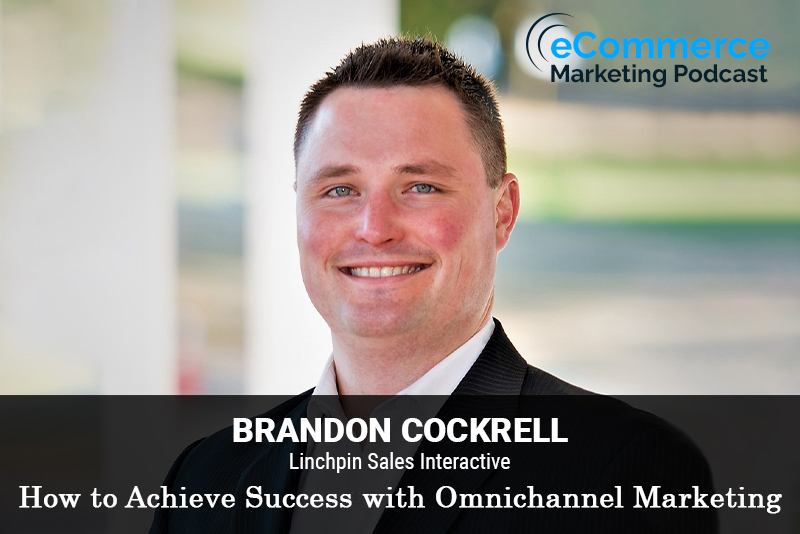
The eCommerce Marketing Podcast walks you through everything that goes into ecommerce marketing — from inbound marketing to paid advertising to conversions. Learn the strategies top marketing experts use to grow their businesses.
Brandon Cockrell has been in the business of marketing, sales, and business development for more than a decade. He is the president of Linchpin Sales Interactive, which he founded in 2016 in order to escape the corporate world and make a real difference in the lives of people looking to grow their brand. He and his team are the marketing geniuses for the modern era. Marketing can make or break any business, and in the new age of e-commerce and everyone working from home, many feel like they’re in uncharted territory. Brandon has been ahead of the game from day one and works to make his clients’ marketing campaigns perform for their businesses.
In this episode, you will learn
What exactly is Omnichannel marketing
How an ecommerce business decides which marketing channels to focus on
What are some tools and resources and best practices for managing marketing campaigns across multiple channels
Examples of some ecommerce businesses that are successful in the Omnichannel marketing game and the things have they done to be successful
For show transcript and past guests, please visit https://www.ecommercemarketingpodcast.com
Or on YouTube at:
https://www.youtube.com/channel/UC3PgT0NOGzpdPGQtBK0XLIQ
Follow Arlen:
Twitter: https://twitter.com/askarlen
Facebook: https://www.facebook.com/arlen.robinson.7
Instagram: https://www.instagram.com/arlenyohance/
LinkedIn: https://www.linkedin.com/in/arlenrobinson/
Past guests on the ecommerce marketing podcast include Neil Patel, Nemo Chu, Luke Lintz, Luke Carthy, Amber Armstrong, Kris Ruby and many more.
Thanks for listening. Be sure to subscribe and leave a review.

Title: The Power of Omnichannel Marketing for E-commerce Businesses – with Brandon Cockrell
Guest: Brandon Cockrell, President of Linchpin Sales Interactive
Host: Arlen Robinson
Summary: In this episode of the eCommerce Marketing Podcast, Arlen Robinson interviews Brandon Cockrell, President of Linchpin Sales Interactive. Brandon shares his journey from the corporate world to founding his own marketing agency. They delve into the importance and strategies of omnichannel marketing for e-commerce businesses, offering insights into how to effectively manage and optimize marketing campaigns across various platforms.
Key Takeaways:
- [00:06:46] Understanding Omnichannel Marketing:
- Definition: Being available everywhere your audience could be, ensuring your brand is consistently visible and engaging across multiple touchpoints.
- [00:08:53] Deciding on the Right Marketing Channels:
- Test different platforms to see where your audience is most active.
- Use platforms like Facebook and Instagram for initial testing due to their broad reach and robust tools.
- [00:13:14] Managing Multiple Campaigns Effectively:
- Use third-party tracking tools like Hyros to accurately track and analyze campaign performance across all platforms.
- Ensure each platform’s content is tailored to its unique audience and format.
- [00:17:31] Best Practices for Omnichannel Marketing:
- Focus on top-performing platforms for initial prospecting and use others for retargeting.
- Always aim to build your own database by collecting customer information.
- [00:20:17] Determining Campaign Duration and Efficacy:
- Run campaigns long enough to gather sufficient data on impressions and engagement.
- Test multiple audiences to identify the best target group.
- [00:23:54] Advantages of Using Professional Agencies:
- Agencies have the expertise to conduct rapid testing and make quick, informed decisions, saving time and money.
- [00:25:09] Successful Omnichannel Campaign Examples:
- Brands like Boom by Cindy Joseph, Snow Teeth Whitening, and Chewy excel at omnichannel marketing.
- Smaller brands can also succeed with modest budgets by leveraging targeted ad campaigns and retargeting.
Guest Info:
- Brandon Cockrell
- President of Linchpin Sales Interactive
- Website: Linchpin Sales Interactive
- Instagram: @LinchpinSales
- New Program: Acquire and Close











